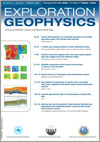
Exploration Geophysics
Volume 44 Number 2 2013
EG12051Towards AEM bathymetry and conductivity estimation in very shallow hypersaline waters of the Coorong, South Australia
A helicopter time-domain EM (HTEM) system was flown along the Coorong which contains very shallow waters ranging from saline to extremely hypersaline. Interpretation of data via 1D inversion shows that HTEM has the potential to detect shallow water depths and conductivity gradients to monitor hypersalinisation in ecologically important wetland areas.
EG13013A random layer-stripping method for seismic reflectivity inversion
Reflectivity series of seismic traces are developed in a random-search scheme by using adaptive simulated annealing as a tool for sparse spiking deconvolution. Then, P-wave velocities are estimated by considering Gardner’s equation for density and velocity. Results of processing Marmousi data using this random layer-stripping algorithm are presented.
EG12047Prestack reverse-time migration with a time-space domain adaptive high-order staggered-grid finite-difference method
In order to improve imaging accuracy, we have developed an acoustic prestack reverse-time migration (RTM) scheme based on the time-space domain high-order staggered-grid finite-difference method. Additionally, we apply adaptive variable-length spatial operators to compute spatial derivatives to decrease computational costs effectively in RTM.
EG12043Reliability measurement of joint seismic inversion based on seismic-to-well correlation
This paper proposes a systematic methodology to measure the reliability of seismic inversions through prior seismic-to-well correlation analyses for the fidelity of seismic data. Case studies from several oilfields show the potential application of the methodology in reducing the uncertainty of seismic inversions in the characterisation of complex reservoirs.
EG12034Quality assurance of aeromagnetic data using lineament analysis
Lineament analysis is implemented for quantifying levelling in an aeromagnetic dataset. A lineament’s azimuth separates geologic sources from artefacts associated with acquisition or pre-processing. Lineaments are displayed as rose diagrams and the numerical difference along specific azimuths before and after pre-processing quantifies the suppression of flight-line variations.
EG12066New methods for interpretation of magnetic vector and gradient tensor data II: application to the Mount Leyshon anomaly, Queensland, Australia
New methods of analysis of magnetic gradient tensor data have been applied to analyse the magnetic signature of the Early Permian Mount Leyshon gold-mineralised system in Queensland.
EG12058Improved edge detection tools in the interpretation of potential field data
In this paper, two improved theta map filters are presented, which use the power transform and the exponential transform of the theta map to recognise the edges of the sources. The advantage of the new filters lies in their ability to delineate the source edges more clearly.
EG12052Heat flow data from the southeast of South Australia: distribution and implications for the relationship between current heat flow and the Newer Volcanics Province
This paper presents 34 new heat flow estimates from the western Otway Basin. The average estimated heat flow is 65.6 mW/m2, with a range of 42–90 mW/m2. Some areas have heat flow that is slightly anomalous, coinciding with dormant Pleistocene-Holocene volcanoes, but the simplest explanation comes from heterogeneous basement heat production.

